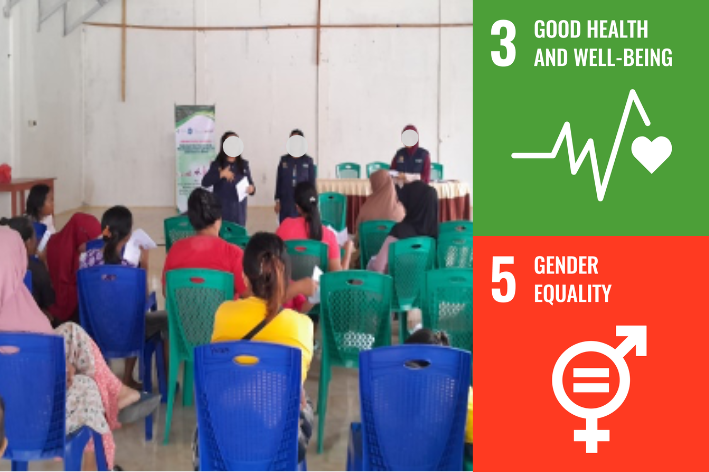Main Article Content
Abstract
Developmental delays in under-five children are a global concern, with a prevalence of approximately 10% worldwide. In Central Sulawesi, the coverage of Early Stimulation, Detection, and Intervention for Growth and Development (SDIDTK) in toddlers remains low at 44.6%. Therefore, this community service activity aimed to enhance the knowledge and skills of posyandu cadres and mothers in Pinedapa Village in monitoring under-five children's development. The methods employed were education and simulation on monitoring child development. The results showed a significant increase in participants' knowledge; 80% of participants previously had poor knowledge, which increased to 100% having good knowledge post-education. Similarly, there was an improvement in participants' skills in monitoring under-five children's development after the simulation. This demonstrates the effectiveness of education and simulation in strengthening the capacity of partners, particularly concerning the monitoring of under-five children's development.
Keywords
Article Details

This work is licensed under a Creative Commons Attribution-NonCommercial 4.0 International License.
References
- Ariani, N., Intani, T. M., Sarli, D., & Poddar, S. (2021). Psychosocial stimulation towards the development of toddler 1 – 3 years old. Malaysian Journal of Medicine and Health Sciences, 17, 88–91.
- Arnold, J., & Diaz, M. C. G. (2016). Simulation training for primary caregivers in the neonatal intensive care unit. Seminars in Perinatology, 40(7), 466–472. https://doi.org/10.1053/j.semperi.2016.08.007
- Bogo, M., Shlonsky, A., Lee, B., & Serbinski, S. (2014). Acting Like It Matters: A Scoping Review of Simulation in Child Welfare Training. Journal of Public Child Welfare, 8(1), 70–93. https://doi.org/10.1080/15548732.2013.818610
- Cahyani, F. I., Komaini, A., Kiram, Y., Purnomo, E., Marheni, E., Akbar, A., & Ockta, Y. (2024). Parental concern: increasing involvement and support for early childhood movement learning activities. Fizjoterapia Polska, 2024(5), 155–161. https://doi.org/10.56984/8ZG020C4AW9
- Dinkes Provinsi Sulawesi Tengah. (2022). Profil Kesehatan Provinsi Sulawesi Tengah.
- Hanum, R., & Safitri, M. E. (2018). Hubungan Pengetahuan dan Sikap Ibu Hamil tentang Pemanfaatan Buku KIA. Jurnal Bidan Komunitas, 1(3), 152–160. https://doi.org/10.33085/jbk.v1i3.3968
- Hayati, N., Muthmainnah, & Fatimaningrum, A. S. (2015). Pelatihan Kader Posyandu dalam Deteksi Perkembangan Anak Usia Dini. Jurnal Pendidikan Anak, 651–658.
- Hendrawati, S., Mardhiyah, A., Mediani, S., Nurhidayah, I., Mardiah, W., Adistie, F., Nur, N., & Maryam, A. (2018). Pemberdayaan Kader Posyandu dalam Stimulasi Deteksi dan Intervensi Dini Tumbuh Kembang (SDIDTK) pada Anak Usia 0-6 Tahun. Media Karya Kesehatan, 1(1). https://doi.org/10.24198/mkk.v1i1.17263
- Hidayat, E. M., & Ambarwati, R. (2018). The role of posyandu cadres in improving the growth and development of toddlers in RW VII Puskesmas Mojo, Surabaya. Indian Journal of Public Health Research and Development, 9(11), 1813–1817. https://doi.org/10.5958/0976-5506.2018.01709.6
- Irawan, N., Budiastutik, I., & Trisnawati, E. (2024). Increasing the Capacity of Mothers of Toddlers in Early Detection of Stunting in Quality Family Village, Bengkayang Regency. Media Publikasi Promosi Kesehatan Indonesia, 7(7), 2038–2043. https://doi.org/10.56338/mppki.v7i7.5351
- Kementerian Kesehatan RI. (2016). Pedoman Pelaksanaan SDIDTKA.
- Kementerian Kesehatan RI. (2018). Profil Kesehatan Indonesia Tahun 2017.
- Kementerian Kesehatan RI. (2021). Profil Kesehatan Indonesia Tahun 2020.
- Kementerian Kesehatan RI. (2022). Profil Kesehatan Indonesia Tahun 2021.
- Kementerian Kesehatan RI. (2024). Profil Kesehatan Indonesia Tahun 2023.
- Rao, P., Vander Schaaf, E. B., Steiner, M. J., & Perry, M. (2023). Normal child growth and development. In Encyclopedia of Child and Adolescent Health, First Edition (Vol. 1, pp. 295–309). https://doi.org/10.1016/B978-0-12-818872-9.00095-9
- Silawati, V., Nurpadilah, & Surtini. (2020). Deteksi Dini Pertumbuhan dan Perkembangananak Usia Dini di Pesantren Tapak Sunan Jakarta Timur. BERNAS: Jurnal Pengabdian Kepada Masyarakat, 1(2), 88–93. https://doi.org/10.31949/jb.v1i2.249
- Sinno, D., Charafeddine, L., & Mikati, M. (2013). Enhancing early child development: A handbook for clinicians. In Enhancing Early Child Development: A Handbook for Clinicians. https://doi.org/10.1007/978-1-4614-4827-3
- Sugeng, H. M., Tarigan, R., & Sari, N. M. (2019). Gambaran Tumbuh Kembang Anak pada Periode Emas Usia 0-24 Bulan. Jurnal Sistem Kesehatan, 4(3), 96–101.
- UNICEF, WHO, & World Bank Group. (2021). Levels and trends of malnutrition: Joint Malnutrition Estimates Key findings of the 2020 edition (pp. 1–16). https://doi.org/10.18356/6ef1e09a-en
- Weningtyas, A., Ma’rufa, P. L., & Fauziah, D. (2023). The effect of short course interventions to improve knowledge of posyandu (integrated service post) cadres in early detection of stunting. Indonesian Journal of Public Health, 18(3), 530–539. https://doi.org/10.20473/ijph.v18i3.2023.530-539
- Widiaskara, L. G. A. P. V., & Windiani, I. G. A. T. (2017). Prevalens Keterlambatan Perkembangan Anak di Taman Kanak-Kanak Sabana Sari, Denpasar Barat. E-Jurnal Medika, 6(9), 34–37.
- Yusniarita, Y., & Sari, W. I. P. E. (2022). Pemberdayaan Ibu Balita dalam Kelas Ibu Balita untuk Meningkatkan Kemampuan Pemantauan Pertumbuhan dan Perkembangan Baita. GEMASSIKA : Jurnal Pengabdian Kepada Masyarakat, 6(1), 34–46. https://doi.org/10.30787/gemassika.v6i1.538

